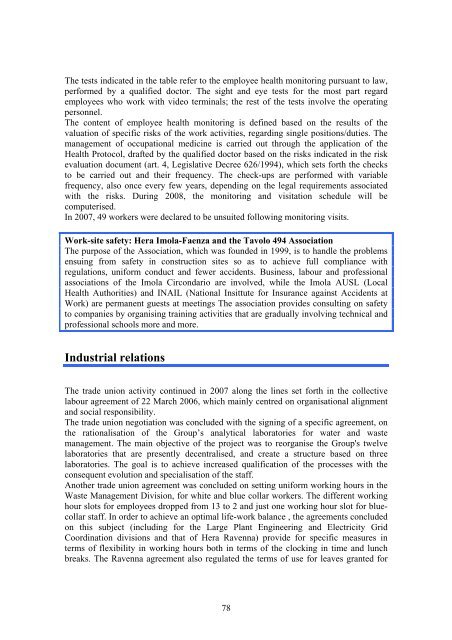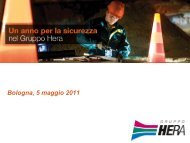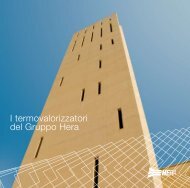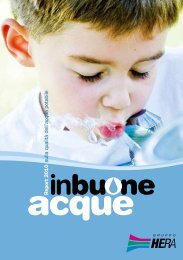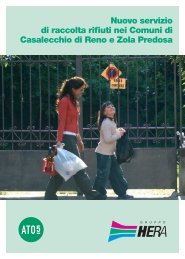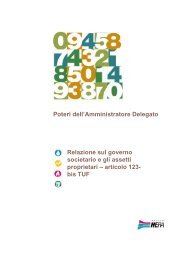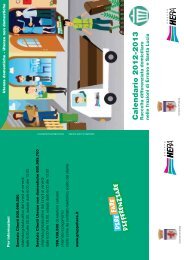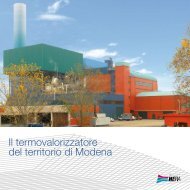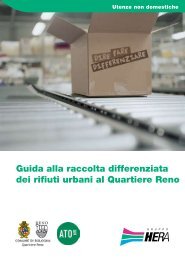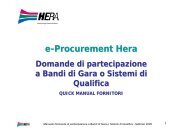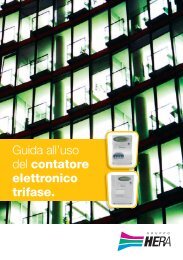Sustainability report 2007 - Il Gruppo Hera
Sustainability report 2007 - Il Gruppo Hera
Sustainability report 2007 - Il Gruppo Hera
Create successful ePaper yourself
Turn your PDF publications into a flip-book with our unique Google optimized e-Paper software.
The tests indicated in the table refer to the employee health monitoring pursuant to law,<br />
performed by a qualified doctor. The sight and eye tests for the most part regard<br />
employees who work with video terminals; the rest of the tests involve the operating<br />
personnel.<br />
The content of employee health monitoring is defined based on the results of the<br />
valuation of specific risks of the work activities, regarding single positions/duties. The<br />
management of occupational medicine is carried out through the application of the<br />
Health Protocol, drafted by the qualified doctor based on the risks indicated in the risk<br />
evaluation document (art. 4, Legislative Decree 626/1994), which sets forth the checks<br />
to be carried out and their frequency. The check-ups are performed with variable<br />
frequency, also once every few years, depending on the legal requirements associated<br />
with the risks. During 2008, the monitoring and visitation schedule will be<br />
computerised.<br />
In <strong>2007</strong>, 49 workers were declared to be unsuited following monitoring visits.<br />
Work-site safety: <strong>Hera</strong> Imola-Faenza and the Tavolo 494 Association<br />
The purpose of the Association, which was founded in 1999, is to handle the problems<br />
ensuing from safety in construction sites so as to achieve full compliance with<br />
regulations, uniform conduct and fewer accidents. Business, labour and professional<br />
associations of the Imola Circondario are involved, while the Imola AUSL (Local<br />
Health Authorities) and INAIL (National Insittute for Insurance against Accidents at<br />
Work) are permanent guests at meetings The association provides consulting on safety<br />
to companies by organising training activities that are gradually involving technical and<br />
professional schools more and more.<br />
Industrial relations<br />
The trade union activity continued in <strong>2007</strong> along the lines set forth in the collective<br />
labour agreement of 22 March 2006, which mainly centred on organisational alignment<br />
and social responsibility.<br />
The trade union negotiation was concluded with the signing of a specific agreement, on<br />
the rationalisation of the Group’s analytical laboratories for water and waste<br />
management. The main objective of the project was to reorganise the Group's twelve<br />
laboratories that are presently decentralised, and create a structure based on three<br />
laboratories. The goal is to achieve increased qualification of the processes with the<br />
consequent evolution and specialisation of the staff.<br />
Another trade union agreement was concluded on setting uniform working hours in the<br />
Waste Management Division, for white and blue collar workers. The different working<br />
hour slots for employees dropped from 13 to 2 and just one working hour slot for bluecollar<br />
staff. In order to achieve an optimal life-work balance , the agreements concluded<br />
on this subject (including for the Large Plant Engineering and Electricity Grid<br />
Coordination divisions and that of <strong>Hera</strong> Ravenna) provide for specific measures in<br />
terms of flexibility in working hours both in terms of the clocking in time and lunch<br />
breaks. The Ravenna agreement also regulated the terms of use for leaves granted for<br />
78


